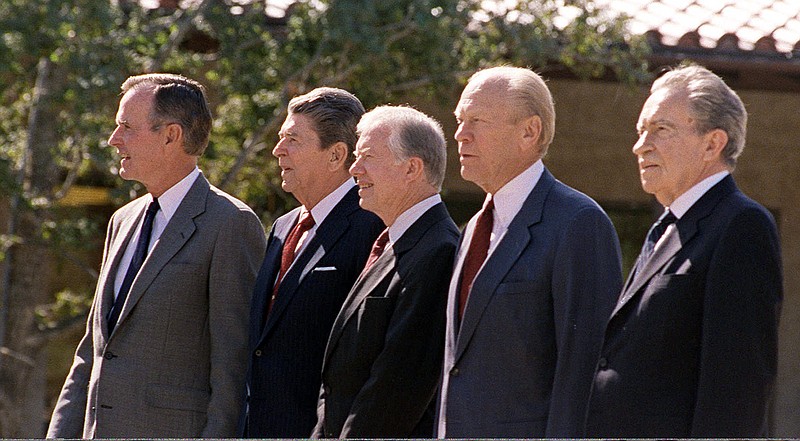Fifty years ago this week, President Richard Nixon announced to the nation a sweeping new welfare reform plan that would include a guaranteed minimum income.
Say what? A Republican president proposed a guaranteed income?
It indeed happened, but we know from the renewed clamor for such today by far left 2020 Democratic presidential candidates that it never saw the light of day.
The original announcement was for $1,500 ($10,469.06 in 2019) to the average family of four, but it later was raised to $1,600 ($11,167 in 2019).
Nixon's idea was that a guaranteed income would be a part of his Family Assistance Program (FAP), which would replace Aid to Families with Dependent Children (AFDC), a program created by the Social Security Act in 1935.
AFDC, over time, had been criticized for creating disincentives to work, and officials in the White House still had their doubts when the president proposed the plan.
An experiment, according to a 2016 article by Rutger Bregman in the online Jacobin, was set up with 8,500 families in the country, with researchers wanting to learn if people would work less with a guaranteed income, if the cost would be too much, and if the plan would be politically feasible.
Although initial figures showed some falloff in work, researchers later believed education, work in the home and searches for better jobs ultimately would show little reduction in work.
Otherwise, the cost appeared to be doable, but the political feasibility remained uncertain. Still, Martin Anderson, special assistant to the president and a former associate professor of finance at the Graduate School of Business at Columbia University, was opposed. He feared the concept of money being considered a basic right and admired philosopher Ayn Rand's views of the smallest possible government with the greatest individual responsibility.
In an attempt to convince Nixon, he gave him a briefing, "A Short History of a Family Security System," which contained descriptions of what was supposed to have resulted from the 19th-century English Speenhamland plan. The plan, it said, dampened productivity and wages, moved the poor to be more idle, and even threatened the foundations of capitalism.
Though the briefing soured the president on the income proposal, his Family Assistance Plan nevertheless was passed by the Democratic-led House 243-155 in 1970. Passage in the Democratic-led Senate was expected, but the plan fell apart when Democrats insisted on the per annum amount being higher.
In 1971, a slightly tweaked version again passed the House 288-132 - Nixon saying "a floor under the income of every family with children in America" was his most important legislative item - but it died again in the Senate.
Since then, the size of the federal government and what all it pays for have grown enormously, but many Democrats angling for the 2020 presidential nomination believe the idea - now soothingly termed "universal basic income" - is still a good one.
It's the centerpiece of the campaign of businessman and former corporate lawyer Andrew Yang, who would give every American over age 18 $1,000 a month with no strings attached as a hedge against a future in which artificial intelligence and other innovations gobble up jobs. The cost of such a plan, according to an estimate by the Center of Budget and Policy Priorities, would be more than $3 trillion a year. Yang would pay for it with "a new tax on the companies benefiting most from automation."
The Green New Deal, embraced by many of the candidates, offers a guaranteed job, which is tantamount to a universal basic income.
Meanwhile, a plan by U.S. Sen. Kamala Harris offers up to $6,000 a year in refundable tax credits for families earning less than $100,000 annually and up to $3,000 for single filers earning below $50,000, and one by U.S. Sen. Cory Booker would give every American child at birth $1,000 in an account managed by the U.S. Treasury Department and up to an additional $2,000 per year, based on family income.
The plan by Harris is estimated to cost more than $270 billion in 2020, according to the Institution on Taxation and Economic Policy, while the type of scheme Booker recommends had a price tag of $80 billion when similar numbers were run in 2015.
Other candidates insist their plans would provide savings for families in so many other areas that a universal basic income would not be immediately necessary.
Even Hillary Clinton, in her 2017 book "What Happened?", indicated that she considered introducing a guaranteed income in her 2016 presidential race but could not make the numbers work.
Indeed, making the numbers work is the crux of the problem in a country nearly $23 trillion in debt. A universal basic income of $1,000 per month would cost around $4 trillion a year, nearly the cost of the entire 2018 federal budget.
Add the cost of proposals such as Medicare for All, free health care for illegal immigrants, free college tuition, free student loan forgiveness and the Green New Deal, and we're talking about amounts in words like quadrillion and quintrillion. It may as well be zillion, though, for all the economic sense it makes.
Just because it was conceivable 50 years ago doesn't mean a guaranteed income is possible today.
